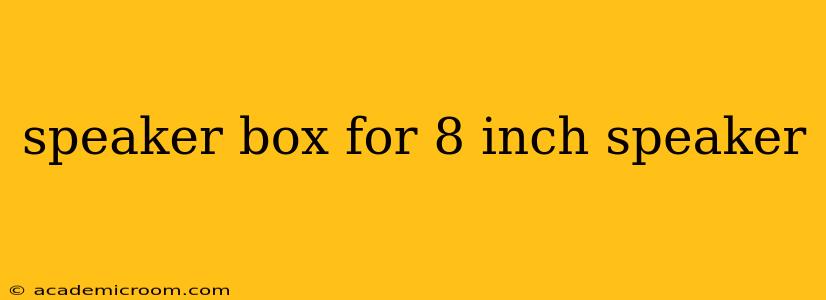Choosing the right speaker box for your 8-inch speaker is crucial for achieving optimal sound quality. The enclosure significantly impacts the speaker's performance, influencing bass response, clarity, and overall sound signature. This guide will delve into the key considerations and design aspects for building or buying a speaker box perfectly suited to your 8-inch driver.
What Type of Enclosure is Best for an 8-Inch Speaker?
The ideal enclosure type depends on your desired sound characteristics and the specific design of your 8-inch speaker. Different enclosures offer different advantages:
-
Sealed (Acoustic Suspension): Sealed enclosures are simple to build, offering tight and controlled bass with good transient response. They're less prone to port noise and are a good choice for accurate reproduction, particularly in smaller spaces. However, they generally produce less overall bass output compared to ported designs.
-
Ported (Bass Reflex): Ported boxes utilize a port (tube) to enhance bass response by resonating with the speaker's cone. This results in louder and more extended low frequencies. However, port design is critical; improper design can lead to port noise or a "boomy" sound. Ported enclosures are generally larger than sealed ones.
-
Bandpass: Bandpass enclosures are more complex, using multiple chambers and ports to create a narrow frequency response band. This results in very strong bass in a specific range but can sacrifice overall clarity and versatility. They're less common for 8-inch speakers unless you are building a subwoofer.
-
Transmission Line: Transmission line enclosures are designed to absorb the back wave of the speaker, leading to incredibly efficient and extended bass response. However, they are very complex to design and build, typically requiring significant space. They're rarely used for home audio 8-inch speakers.
What are the Dimensions for an 8-Inch Speaker Box?
There's no one-size-fits-all answer to this question. The ideal dimensions depend on the enclosure type (sealed, ported, etc.) and the speaker's Thiele-Small parameters (TS parameters). These parameters, provided by the speaker manufacturer, describe the speaker's mechanical and electrical characteristics, crucial for accurate box design.
Using these parameters, you can use speaker design software (WinISD, BassBox Pro, etc.) to calculate the optimal box volume and port dimensions for your chosen enclosure type. Without this data, providing specific dimensions is unreliable and could lead to suboptimal performance.
How Much Internal Volume Does an 8-Inch Speaker Need?
The required internal volume depends heavily on the speaker's TS parameters and the chosen enclosure type. A sealed enclosure typically requires a smaller volume than a ported enclosure for the same speaker. Again, using speaker design software with the manufacturer's TS parameters is essential for determining the precise volume.
What Material Should I Use for an 8-Inch Speaker Box?
Common materials for speaker boxes include:
-
Medium-Density Fiberboard (MDF): This is the most popular choice due to its density, rigidity, and damping properties, resulting in a cleaner sound.
-
Particleboard: A more affordable option than MDF but less rigid, potentially resulting in more cabinet resonance.
-
Plywood: Offers good strength and rigidity but can be more challenging to work with.
The thickness of the material is also important. Thicker material generally reduces unwanted vibrations and resonance.
Can I Build an 8-Inch Speaker Box Myself?
Yes, building a speaker box yourself is certainly possible, particularly for sealed enclosures. However, it requires careful planning, precise measurements, and woodworking skills. Using speaker design software is crucial to determine the correct dimensions, and you'll need tools like a saw, drill, and possibly a router. There are numerous online resources and tutorials available to guide you through the process.
Remember that precise construction is crucial for achieving optimal sound. Inaccurate cuts or assembly can significantly impact the final sound quality.
Conclusion:
Designing and building (or buying) the correct speaker enclosure is vital for unleashing the full potential of your 8-inch speaker. By understanding the different enclosure types, utilizing speaker design software with the speaker's TS parameters, and carefully choosing materials and construction methods, you can ensure your speaker sounds its absolute best.
